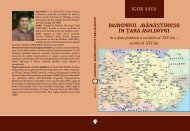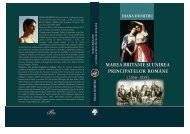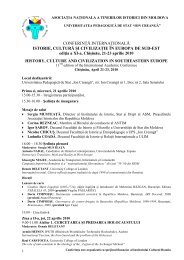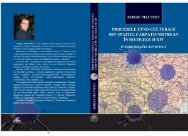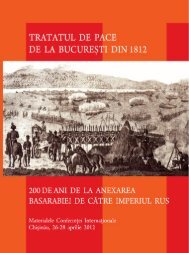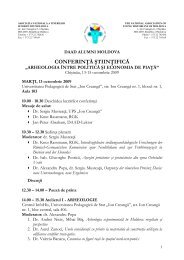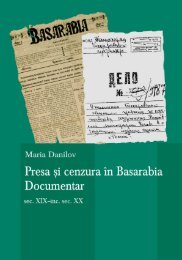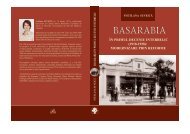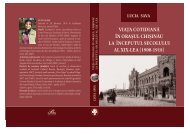Publicatie cu continut integral - Asociatia Tinerilor Istorici din Moldova
Publicatie cu continut integral - Asociatia Tinerilor Istorici din Moldova
Publicatie cu continut integral - Asociatia Tinerilor Istorici din Moldova
You also want an ePaper? Increase the reach of your titles
YUMPU automatically turns print PDFs into web optimized ePapers that Google loves.
internaţionale, unei societăţi democratice. Din punct de vedere economic însă, or reforma a vizat în primul rînd<br />
reformarea agri<strong>cu</strong>lturii <strong>din</strong> puncte de vedere economic, împroprietărirea ţăranilor a dus la o parcelare excesivă a<br />
exploatărilor agricole, ceea ce a avut drept consecinţă diminuarea productivităţii muncii în complexul agroindustrial<br />
şi, drept rezultat, o scădere radicală a volumului producţiei agricole în republică, şi aceasta în toate ramurile<br />
(zootehnie, fitotehnie, industria conservelor, vinificaţia etc.). Reforma a modificat radical şi modul de viaţă al<br />
ţăranilor moldoveni, altădată simpli angajaţi în sectorul agrar al RSSM, pomeniţi în cîţiva ani „proprietari”de terenuri<br />
agricole pe care nu aveau <strong>cu</strong> ce să le prelucreze-nici sub aspectul tehnicii agricole, nici al îngrăşămintelor,<br />
pesticidelor etc., neavînd, aşadar, nici o posibilitate de a obţine rezultate satisfăcătoare în urma muncii lor.Astfel,<br />
în condiţiile unei agri<strong>cu</strong>lturi absolut ineficiente, de subzistenţă, ţărănimea a început să se desţărănizeze, emigrînd<br />
peste hotarele ţării în căutarea unui loc de muncă.<br />
Toate cele expuse mai sus ne fac să apreciem procesul reformei agrare desfăşurate în Republica <strong>Moldova</strong> în<br />
ultimii 15 ani drept un mare eşec, nu doar sub aspect economic, ci şi sub aspect social.<br />
Summary<br />
During the last decade of the past century (so-called transition period), Republic of <strong>Moldova</strong> was characterized<br />
by a wide process of reforming the economy, especially in the area of property. One of the main areas of general<br />
property reform was the land property.<br />
Starting from 1989 the land property was transferred, step by step, in private property, maintaining a limited<br />
state-owned sector. During 1992-1996 the process of land distributing toward peasants was extremely lent, and<br />
only starting with 1998 the process begun to take more speed. As result of land distribution to farmers, in 2002<br />
the most of the lands were already private, but extremely divided into a small exploitations-very hard to be used<br />
in a modern agri<strong>cu</strong>lture .The agri<strong>cu</strong>ltural output diminished by more than a half compared with 1990/1991 data.<br />
However, after the distribution of lands in private property, the most of it became loaned from peasants by big<br />
agri<strong>cu</strong>ltural companies (75 % of lands in 2002 were consolidated in exploitations of more than 100 hectares).<br />
The process of reform caused very important mutations in the peasant’s way of life and even in the field of their<br />
mentality. We consider that the perception of the agri<strong>cu</strong>ltural reform is quite different from the content of reform<br />
under formal aspects. Another goal of this article is also to draft some considerations for clearing the processes<br />
in the field of studying the problem of changing mentality and reform perception by peasants in post-communist<br />
<strong>Moldova</strong>. It is important to know from this viewpoint that the agri<strong>cu</strong>ltural reform in <strong>Moldova</strong> was caused the<br />
emergence of some new social classes by comparison with Soviet period-the big land owners, the small land<br />
owners (not really a capitalist social class in <strong>Moldova</strong>) and those with no land in property, imposed to work for an<br />
extremely small wage in agri<strong>cu</strong>lture. As result of it, a big part of small owners and those with no land in property<br />
were imposed to emigrate out border searching for a better life, the process of emigration being an aspect of disappearing<br />
of peasants as an important social category in <strong>Moldova</strong>.<br />
The short evolution of the process of land property transformation, under economic, juridical and statistical<br />
aspects, as well as the transformations in the area on mentality is the subject of the article to follow.<br />
Bibliografie<br />
1. Konstitutsia Soyuza Sovetskih Socialističeskih Respublik, Moskva, 1977.<br />
2. Legi, hotărîri şi alte acte adoptate de către sesiunea a cincea a Sovietului Suprem al RSS <strong>Moldova</strong> de legislatura a douăsprezecea,<br />
vol.II, Chişinău, 1991.<br />
3. Legi, hotărîri şi alte acte adoptate de către sesiunea a cincea a Sovietului Suprem al RSS <strong>Moldova</strong> de legislatura a douăsprezecea,<br />
vol.III, Chişinău, 1991.<br />
4. Legislaţia funciară, Chişinău, 1996.<br />
5. Monitorul Oficial, nr.147-149, Chişinău, 2001.<br />
6. Sobranie postanovlenii pravite’stva SSSR, nr. 19-20, Moskva, 1989.<br />
7. Veştile Congresului Deputaţilor Poporului şi ale Sovietului Suprem al Uniunii Republicilor Sovietice Socialiste, nr. 9,<br />
Moscova, 1990.<br />
8. Veştile Congresului Deputaţilor Poporului şi ale Sovietului Suprem al Uniunii Republicilor Sovietice Socialiste, nr. 11,<br />
Moscova, 1990.<br />
– –



